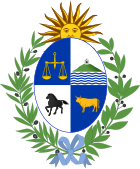 |
|---|
|
|
The National Council of Administration (Spanish: Consejo Nacional de Administración) was part of the executive power in Uruguay between 1919 and 1933, ruling alongside the President of the Republic.[1]
The colegiado system was proposed by President José Batlle y Ordóñez during his second term in office, with the aim of creating an executive body similar to the Swiss Federal Council.[1] Batlle had been opposed to the presidential system, believing that a collegiate body would lower the risk of a dictatorship emerging.[1] Although the proposal was unsuccessful in 1916, Batlle negotiated a compromise with the National Party to include the system in a new constitution approved in a 1917 referendum.[1]
The compromise provided for a president and a nine-member National Council of Administration, which consisted of six members of the winning party and also three from the runner-up party.[1] The president was responsible for foreign affairs, national security and agriculture, whilst the NCA oversaw the budget, education, healthcare, industry, industrial relations, labour, livestock and public works.[1] The National Council of Administration had a chairman distinct from the president, making Uruguay the second Latin american country, after Peru, to have a prime minister with the adoption of the 1917 constitution.
Although the new system worked well in its early years, in the early 1930s a series of conflicts involving the council and the president led to a presidential coup by Gabriel Terra in 1933. A new constitution was drawn up, which abolished the National Council of Administration.[1]